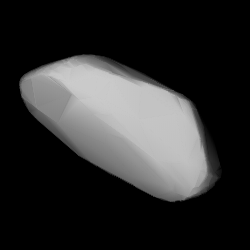1099 Figneria, provisional designation 1928 RQ, is an asteroid from the background population of the outer regions of the asteroid belt, approximately 26 kilometers in diameter. Discovered by Grigory Neujmin at Simeiz Observatory in 1928, the asteroid was later named after Russian revolutionary activist Vera Figner.

1110 Jaroslawa is a bright background asteroid and rather slow rotator from the inner regions of the asteroid belt. The stony S-type asteroid has a rotation period of 97.4 hours and measures approximately 13 kilometers in diameter. It was discovered at the Simeiz Observatory on the Crimean peninsula on 10 August 1928, by astronomer Soviet Grigory Neujmin, who named it after his son, Jaroslav Grigorevich Neujmin.

1129 Neujmina is an Eos asteroid from the outer regions of the asteroid belt. It was discovered on 8 August 1929, by astronomer Praskoviya Parchomenko at the Simeiz Observatory on the Crimean peninsula. The stony S-type asteroid has a rotation period of 5.1 hours and measures approximately 34 kilometers in diameter. It was named after Soviet astronomer Grigory Neujmin.
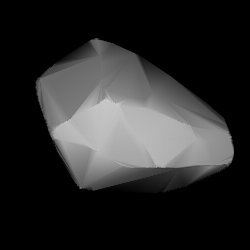
1137 Raïssa is a stony background asteroid and slow rotator, approximately 22 kilometers in diameter, located in the inner regions of the asteroid belt. It was discovered by Grigory Neujmin at Simeiz Observatory in 1929, and named in memory of Raïssa Maseeva, who worked at the Pulkovo Observatory.

1140 Crimea, provisional designation 1929 YC, is a stony asteroid from the middle region of the asteroid belt, approximately 28 kilometers in diameter. It was discovered on 30 December 1929, by Soviet astronomer Grigory Neujmin at Simeiz Observatory on the Crimean peninsula, after which it was named.
1146 Biarmia, provisional designation 1929 JF, is a metallic background asteroid from the outer regions of the asteroid belt, approximately 32 kilometers in diameter. It was discovered on 7 May 1929, by Russian astronomer Grigory Neujmin at the Simeiz Observatory on the Crimean peninsula. The asteroid was named for the Bjarmaland mentioned in Norse sagas.
1158 Luda, provisional designation 1929 QF, is a stony asteroid from the middle regions of the asteroid belt, approximately 19 kilometers in diameter. It was discovered on 31 August 1929, by Soviet astronomer Grigory Neujmin at Simeiz Observatory on the Crimean peninsula. It was named after Ludmilla Neujmin, the sister of the discoverer.

1277 Dolores is a carbonaceous background asteroid from the central regions of the asteroid belt, approximately 27 kilometers in diameter. It was discovered on 18 April 1933, by Soviet astronomer Grigory Neujmin at the Simeiz Observatory on the Crimean peninsula. The asteroid was named after Spanish communist Dolores Ibárruri.

1188 Gothlandia, provisional designation 1930 SB, is a stony Florian asteroid from the inner regions of the asteroid belt, approximately 12 kilometers in diameter. Discovered by astronomer Josep Comas i Solà at the Fabra Observatory in 1930, the asteroid was later named after the ancient name of the Spanish autonomous community of Catalonia.
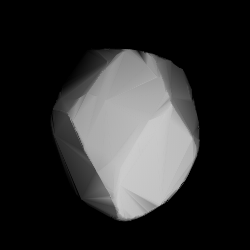
1281 Jeanne is a dark asteroid from the background population of the intermediate asteroid belt. It was discovered on 25 August 1933, by astronomer Sylvain Arend at the Royal Observatory of Belgium in Uccle, who named it after his daughter, Jeanne. The likely P-type asteroid has a rotation period of 15.2 hours and measures approximately 22 kilometers in diameter.
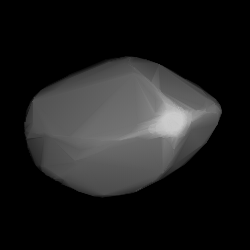
1379 Lomonosowa is a stony background asteroid from the central regions of the asteroid belt, approximately 19 kilometers in diameter. Discovered by Grigory Neujmin at the Simeiz Observatory in 1936, the asteroid was later named after Russian physicist and astronomer Mikhail Lomonosov.
1176 Lucidor, provisional designation 1930 VE, is a carbonaceous background asteroid from the central region of the asteroid belt, approximately 30 kilometers in diameter. It was discovered by Eugène Delporte in 1930, who named it after a friend.
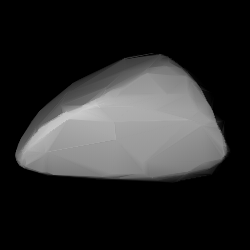
1353 Maartje, provisional designation 1935 CU, is an Eoan asteroid from the outer regions of the asteroid belt, approximately 37 kilometers in diameter. It was discovered on 13 February 1935, by Dutch astronomer Hendrik van Gent at the Union Observatory in Johannesburg, South Africa. The asteroid was named after Maartje Mekking, daughter of a staff member at the Dutch Leiden Observatory.
1347 Patria, provisional designation 1931 VW, is a carbonaceous asteroid from the background population of the central asteroid belt, approximately 32 kilometers in diameter. It was discovered on 6 November 1931, by Soviet astronomer Grigory Neujmin at the Simeiz Observatory on the Crimean peninsula. The asteroid was named for the Latin word of fatherland.

1291 Phryne, provisional designation 1933 RA, is an Eoan asteroid from the outer regions of the asteroid belt, approximately 27 kilometers in diameter. It was discovered on 15 September 1933, by Belgian astronomer Eugène Delporte at the Royal Observatory of Belgium in Uccle. The asteroid was named after the ancient Greek courtesan Phryne.
1306 Scythia, provisional designation 1930 OB, is a dark Ursula asteroid from the outer regions of the asteroid belt, approximately 72 kilometers in diameter. It was discovered on 22 July 1930, by Soviet astronomer Grigory Neujmin at the Simeiz Observatory on the Crimean peninsula. The asteroid was named for the historic region of Scythia.
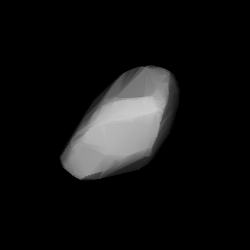
1339 Désagneauxa, provisional designation 1934 XB, is a stony Eoan asteroid from the outer region of the asteroid belt, approximately 24 kilometers in diameter. It was discovered on 4 December 1934, by French astronomer Louis Boyer at the North African Algiers Observatory in Algeria. A few nights later, the asteroid was independently discovered by astronomers Grigory Neujmin and Eugène Delporte, at the Crimean Simeiz and Belgian Uccle Observatory, respectively. It was later named after discoverer's brother-in-law.

1289 Kutaïssi is a stony Koronian asteroid from the outer region of the asteroid belt. Discovered by Grigory Neujmin at Simeiz Observatory in 1933, it was later named after the Georgian city of Kutaisi. The S-type asteroid has a rotation period of 3.6 hours and measures approximately 22 kilometers in diameter.

1407 Lindelöf, provisional designation 1936 WC, is an asteroid from the central region of the asteroid belt, approximately 20 kilometers in diameter. It was discovered on 21 November 1936, by Finnish astronomer Yrjö Väisälä at Turku Observatory in Southwest Finland. The asteroid was named after Finnish topologist Ernst Lindelöf.
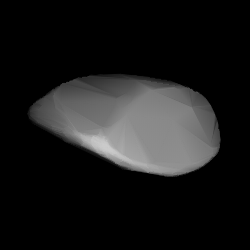
1545 Thernöe is an elongated background asteroid from the central region of the asteroid belt. It was discovered on 15 October 1941, by Finnish astronomer Liisi Oterma at Turku Observatory in Southwest Finland. The uncommon K-type asteroid has a rotation period of 16.1 hours and measures approximately 18 kilometers in diameter. It was later named after Danish astronomer Karl August Thernöe.
